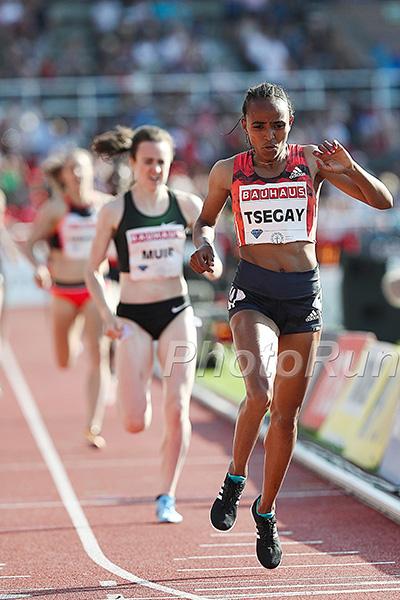Guda Tsegay, Laura Muir, Stockholm DL 1,500 meters, photo by PhotoRun.net
RelatedPosts
This is Stuart Weir’s column on the women’s 1,500 meters, the last event on the Bauhaus Galan schedule. Stuart had some fascinating observances on the rather unique approach to pace making as exemplified in the women’s 1,500 meters in Stockholm.
Women’s 1500
The final race in today’s program was the women’s 1500 meters and it was worth waiting for. The race had two designated pacemakers, who set off a great place leaving all the runners far behind. Laura Muir told me that the pacemakers were supposed to take the runners through the first 400 metres in about 64 seconds. In reality, they were 5 seconds faster than that. As Laura said: “It’s a bit frustrating when pacemakers run like that especially when they’re told the splits to run”.
Incidentally, this was not the first time that Laura and I had talked about pacemakers. I had shared with her at the 2017 British Athletics Writers’ Awards Lunch that I myself have a heart pacemaker. This was at a time when Laura was studying the cardiology of horses. Being the nice girl she is she pretended to be interested.
Gudaf Tsegay, a 21 year old Ethiopian won today’s race in 3:57.64 – a PR by 1.9 seconds – to set a new Meeting Record, beating Maryam Jamal’s record which had stood since 2006. Tsegay, who opened up a big lead but was being run-down by Muir, said after the race: “Today I am happy because I have run well and I felt strong. The field was very high quality. I was confident. Now I want to improve my time so a good time is my target”.
Muir, who had also run in Oslo, pronounced herself pleased with her week’s work – a sub 2 minute 800 and sub 4 minute 1500 in the space of 4 days. Muir is also relatively inexperienced as a full-time professional athlete – as she only completed her Veterinary Sciences degree two weeks ago!
Muir shrugged off the eccentric pacemaking saying: “I’m lucky that I’ve got a good internal clock and I know how to pace races and was able to do pretty good splits myself, so it didn’t really bother me. But it did mean that I was in no man’s land without any help for a bit but it was fine. I just had to work towards the front and nearly got to the very front. I was closing on the leader in the last straight but it was just too much”.
Of her own performance she pointed out that her time of 3:58.33 was not only almost a second faster than at Pre but would have been a winning time at Pre.
Rababe Arafi (Morocco) was third and Jenny Simpson fourth. Simpson tweeted: “4:00 for 4th today at Stockholm Diamond League. Good but not good enough. Proud of my fitness but not my finish. More work to do”.
But the heroine of the day was Gudaf Tsegay – who needed and achieved a PR to win. As Laura Muir told me: “She had a good run on the day and hats off to her”.
It is the magic of the Diamond League that it can produce great races like this and can produce unexpected but thoroughly deserving winners.
Author

Since 2015, Stuart Weir has written for RunBlogRun. He attends about 20 events a year including all most global championships and Diamond Leagues. He enjoys finding the quirky and obscure story.
View all posts





















